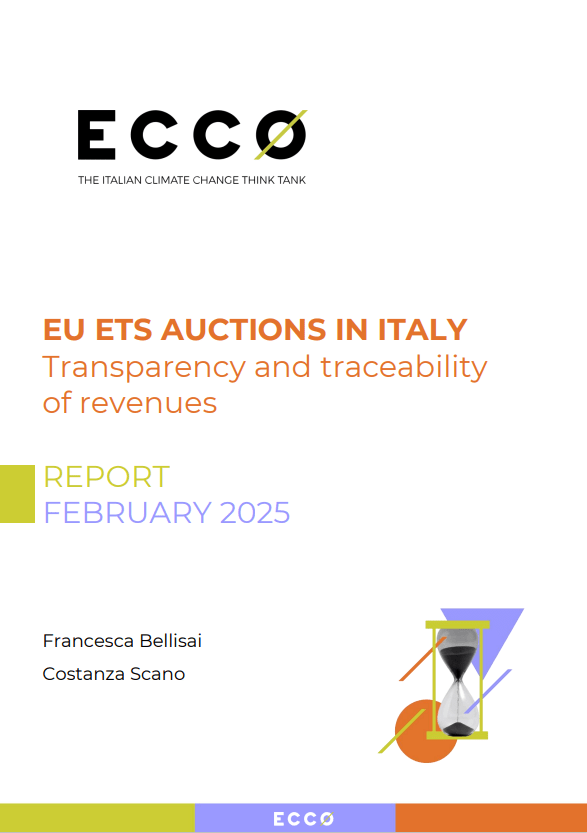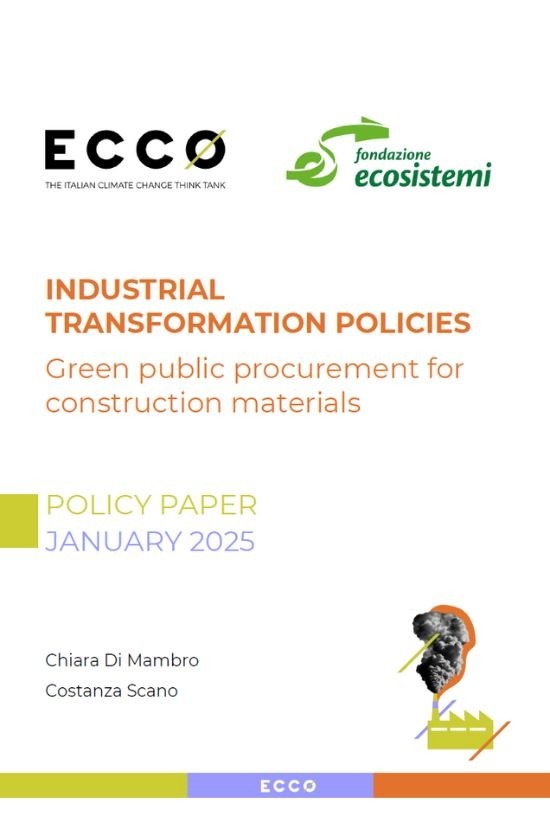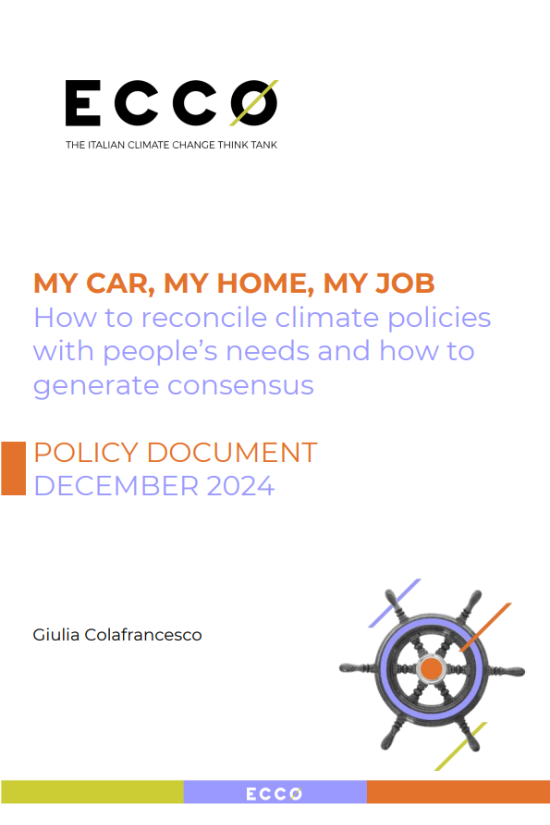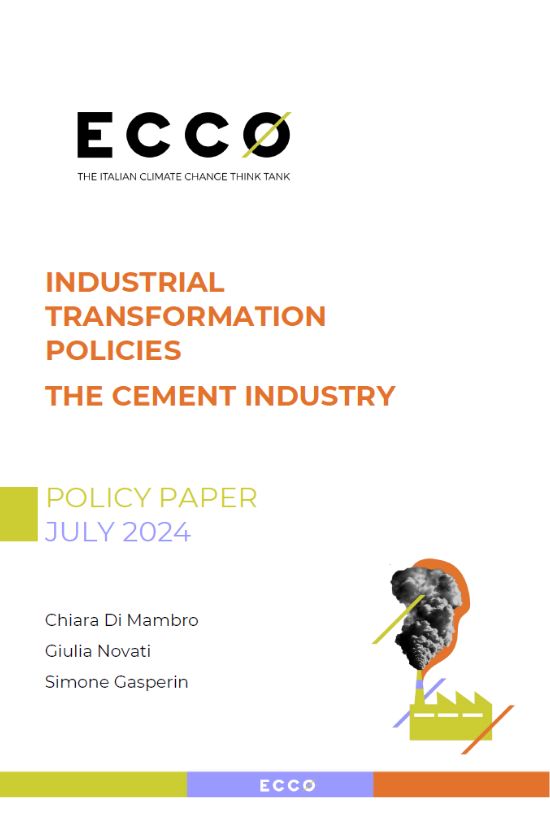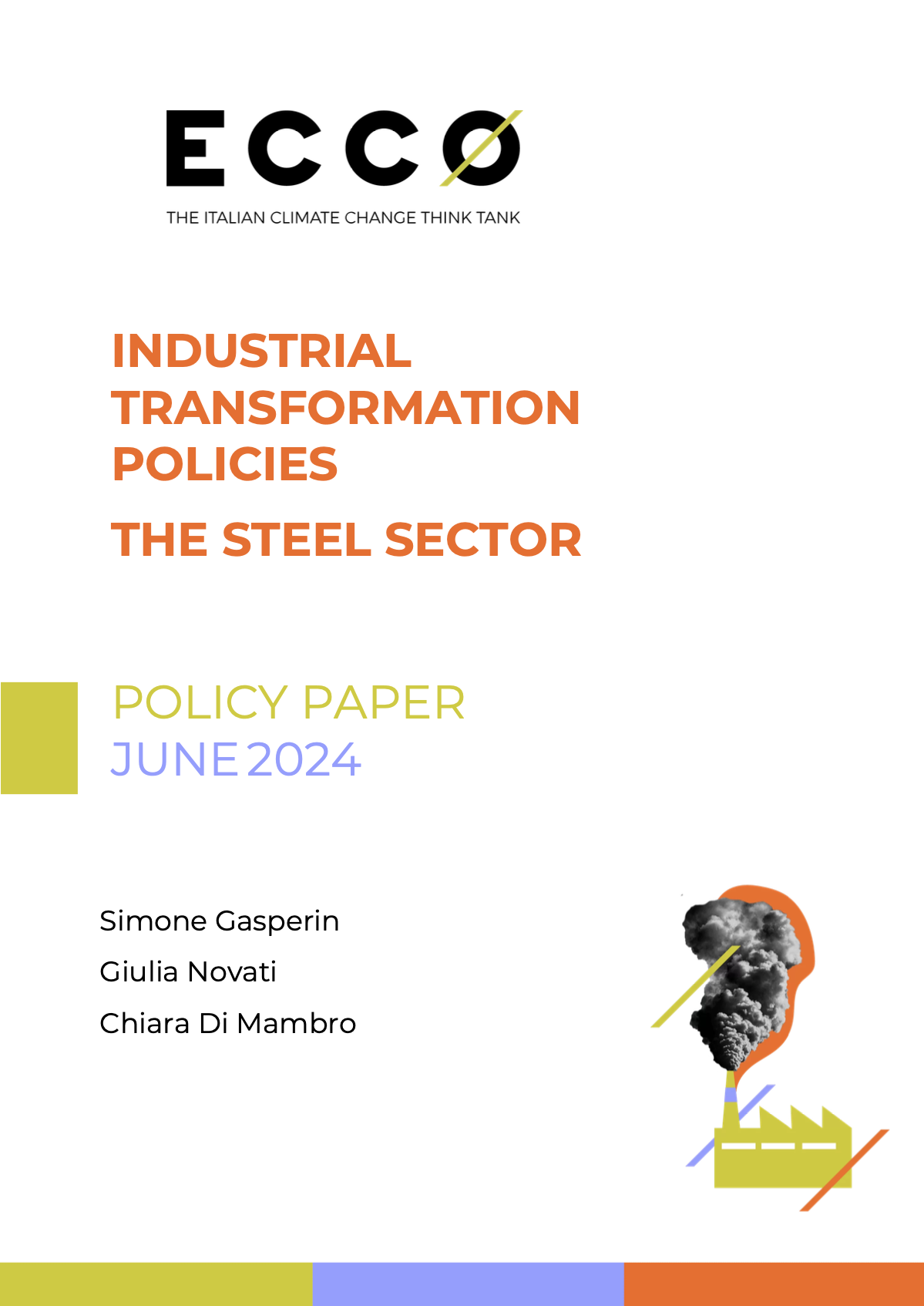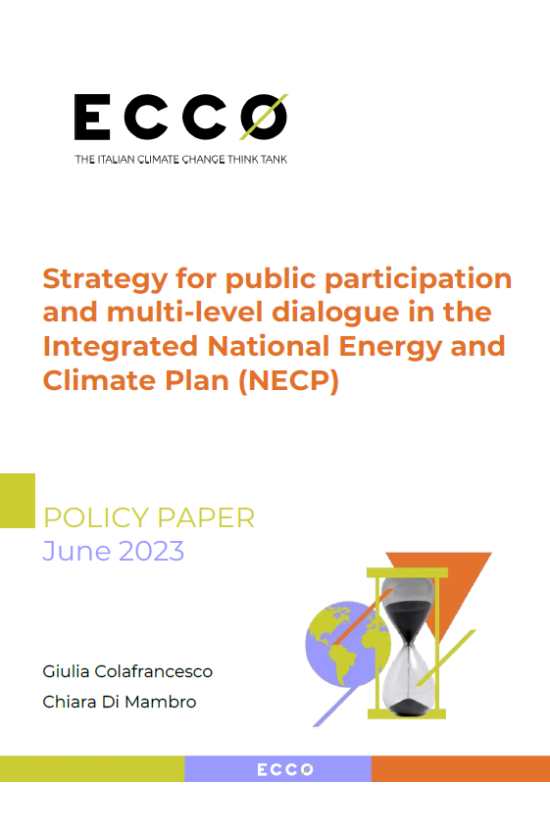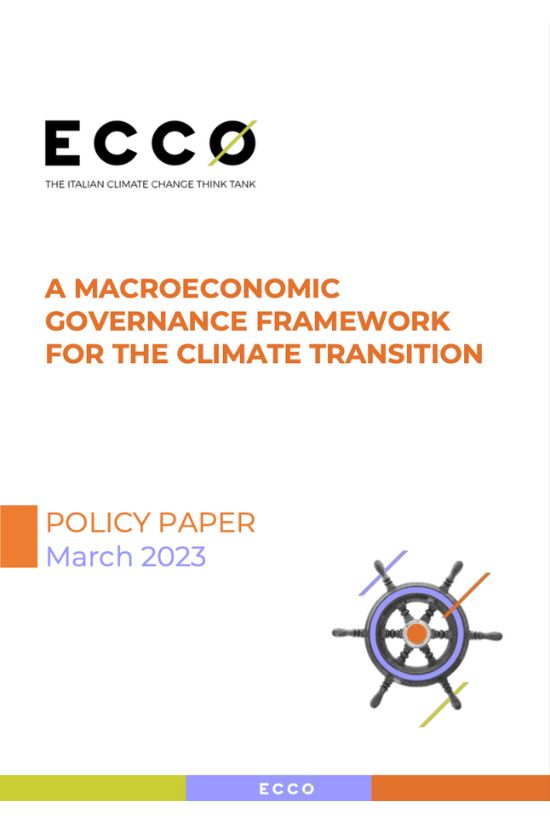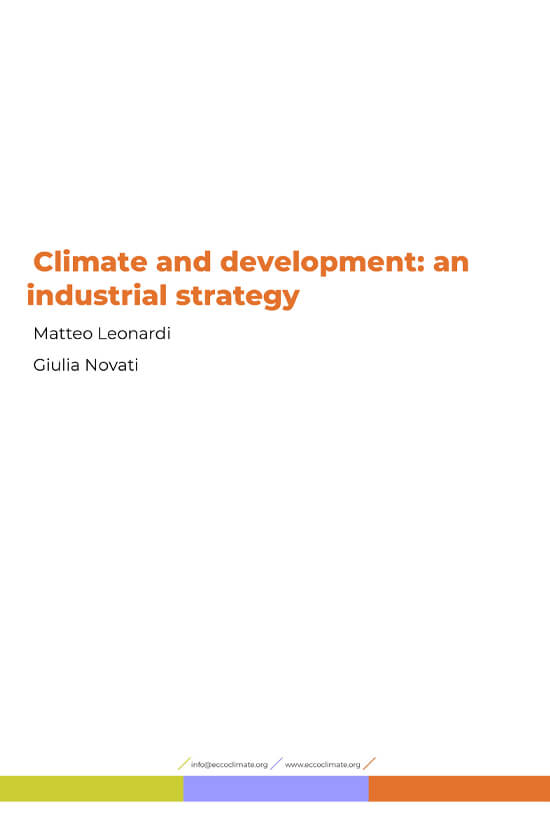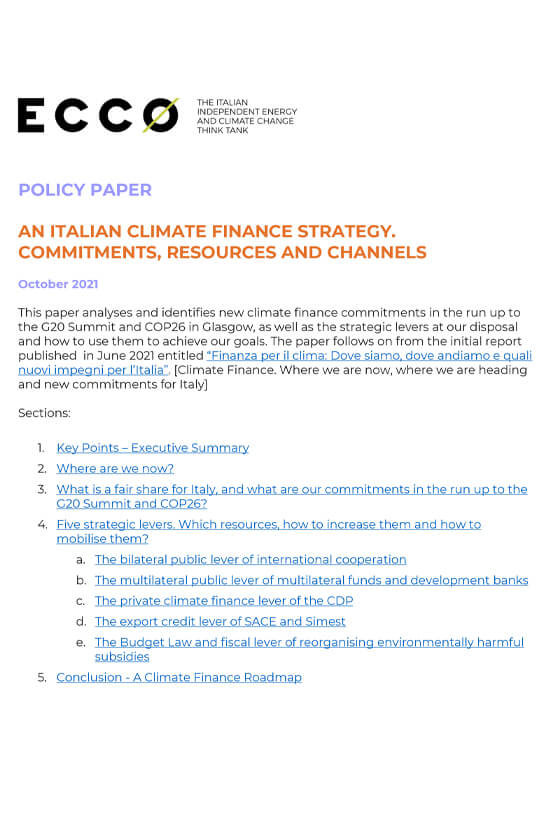Publications
Search
Filters
Authors
/ Alexandra Scott
/ Andrea Ghianda
/ Annalisa Perteghella
/ Beatrice Moro
/ Carolina Bedocchi
/ Caterina Molinari
/ Chiara Di Mambro
/ Chiara Mariotti
/ Chloe Pagliaro
/ Costanza Scano
/ Davide Panzeri
/ ECCO think thank
/ Eleonora Cogo
/ Federico Tassan-Viol
/ Filomena Annunziata
/ Francesca Andreolli
/ Francesca Bellisai
/ Gabriele Cassetti
/ Giovanni D'Amico
/ Giulia Colafrancesco
/ Giulia Giordano
/ Giulia Novati
/ Giulia Signorelli
/ Ilaria Mazzocco
/ Lorena Stella Martini
/ Luca Bergamaschi
/ Luca Iacoboni
/ Mario Noera
/ Marta Lovisolo
/ Massimiliano Bienati
/ Matteo Leonardi
/ Matteo Viola
/ Michele Governatori
/ Nicolas Drago
In this paper, we have assessed how the NRRP is being implemented and its current contribution to the achievement of climate objectives, four years after its adoption. To determine its progress, we have selected and examined a number of climate flagship measures within it, two reforms and four investments relevant to the climate and the energy transition. Based on the findings from our analysis, we have prepared policy recommendations that can inform discussions around the next Multiannual Financial Framework for the 2028-2034 period.
An analysis of the public reports submitted by Italy to the European Commission between 2014 and 2024 highlights issues with the use of revenues generated from EU ETS auctions. Reviewing the revenues from the ETS auctions reveals significant shortcomings in expenditure planning and fund traceability, with only nine percent of the revenues generated by the system have been allocated to measures addressing climate change.
The drive to innovate that has resulted from the need to meet today’s decarbonisation objectives has
given rise to a new industrial revolution based on clean technology. This policy briefing, which analyses the current situation in relation to public procurement legislation in Europe and Italy, sets out a proposal for revising the minimum environmental criteria for the public procurement of construction materials, which are currently under review.
This document is a first contribution to support policy makers in finding the right tools to interpret the needs of our society along the process of transition away from fossil fuels, as well as building a consensus based political proposal and a shared framework of reference based on the principles outlined in this document. Further, it opens a season of social studies aimed at exploring social, economic and cultural drivers of behaviours in relation to climate action.
This analysis proposes a simplified and aggregated policy framework that’s consistent with the transition towards climate neutrality as well as an outline and assessment of the policies currently in place in the cement industry in Italy, which is the second largest producer of cement in the European Union and a major consumer of cement and concrete.
The biggest obstacle for zero/low emission or green steel is the simple fact that, within the current market, it isn’t cost-competitive. In light of the complex regulatory framework that has been developed around energy and climate objectives, this policy paper offers a perspective and a conceptual outline for defining a policy framework that’s consistent with the country's emission reduction goals.
Italy, like other European countries, has been called upon to structure the process of updating the Integrated National Energy and Climate Plan (NECP) through public participation and effective multi-level dialogue, as envisaged by the Energy Union Governance Regulations and reiterated by the Commission’s Guidelines for revision of the Plan. This work shows the availability of resources, time and knowledge to make the NECP a plan that reflects the needs of the country, through a participation-based path.
The ecological transition is crucial not only for achieving the climate goals contained in the European Green Deal, but also the innovation and industrial competitiveness goals of the Green Deal Industrial Plan. The transition is therefore a prerequisite for growth and thus for debt sustainability.
Italy is the second largest steel producer in Europe and the 11th largest in the world. In 2019, 23.2 Mt of steel was produced at the Acciaierie d'Italia plant in Taranto (Ex Ilva). In this report we take an in-depth look at steel production in Italy, analyzing the specific case of the only Italian plant that currently produces it, namely the Taranto steel plant
Full decarbonization by 2050 requires the development of new industrial strategies aligned with climate goals. In this study, we delve into emission reduction technology options and suggest industrial decarbonization strategies to address climate change through the levers of innovation, welfare, and employment.
Ahead of the G20 Heads of State and Government Summit in Rome and COP26 in Glasgow, we analysed and identified Italy's climate finance commitments.
In this paper, we have assessed how the NRRP is being implemented and its current contribution to the achievement of climate objectives, four years after its adoption. To determine its progress, we have selected and examined a number of climate flagship measures within it, two reforms and four investments relevant to the climate and the energy transition. Based on the findings from our analysis, we have prepared policy recommendations that can inform discussions around the next Multiannual Financial Framework for the 2028-2034 period.
An analysis of the public reports submitted by Italy to the European Commission between 2014 and 2024 highlights issues with the use of revenues generated from EU ETS auctions. Reviewing the revenues from the ETS auctions reveals significant shortcomings in expenditure planning and fund traceability, with only nine percent of the revenues generated by the system have been allocated to measures addressing climate change.
The drive to innovate that has resulted from the need to meet today’s decarbonisation objectives has
given rise to a new industrial revolution based on clean technology. This policy briefing, which analyses the current situation in relation to public procurement legislation in Europe and Italy, sets out a proposal for revising the minimum environmental criteria for the public procurement of construction materials, which are currently under review.
This document is a first contribution to support policy makers in finding the right tools to interpret the needs of our society along the process of transition away from fossil fuels, as well as building a consensus based political proposal and a shared framework of reference based on the principles outlined in this document. Further, it opens a season of social studies aimed at exploring social, economic and cultural drivers of behaviours in relation to climate action.
This analysis proposes a simplified and aggregated policy framework that’s consistent with the transition towards climate neutrality as well as an outline and assessment of the policies currently in place in the cement industry in Italy, which is the second largest producer of cement in the European Union and a major consumer of cement and concrete.
The biggest obstacle for zero/low emission or green steel is the simple fact that, within the current market, it isn’t cost-competitive. In light of the complex regulatory framework that has been developed around energy and climate objectives, this policy paper offers a perspective and a conceptual outline for defining a policy framework that’s consistent with the country's emission reduction goals.
Italy, like other European countries, has been called upon to structure the process of updating the Integrated National Energy and Climate Plan (NECP) through public participation and effective multi-level dialogue, as envisaged by the Energy Union Governance Regulations and reiterated by the Commission’s Guidelines for revision of the Plan. This work shows the availability of resources, time and knowledge to make the NECP a plan that reflects the needs of the country, through a participation-based path.
The ecological transition is crucial not only for achieving the climate goals contained in the European Green Deal, but also the innovation and industrial competitiveness goals of the Green Deal Industrial Plan. The transition is therefore a prerequisite for growth and thus for debt sustainability.
Italy is the second largest steel producer in Europe and the 11th largest in the world. In 2019, 23.2 Mt of steel was produced at the Acciaierie d'Italia plant in Taranto (Ex Ilva). In this report we take an in-depth look at steel production in Italy, analyzing the specific case of the only Italian plant that currently produces it, namely the Taranto steel plant
Full decarbonization by 2050 requires the development of new industrial strategies aligned with climate goals. In this study, we delve into emission reduction technology options and suggest industrial decarbonization strategies to address climate change through the levers of innovation, welfare, and employment.
Ahead of the G20 Heads of State and Government Summit in Rome and COP26 in Glasgow, we analysed and identified Italy's climate finance commitments.

